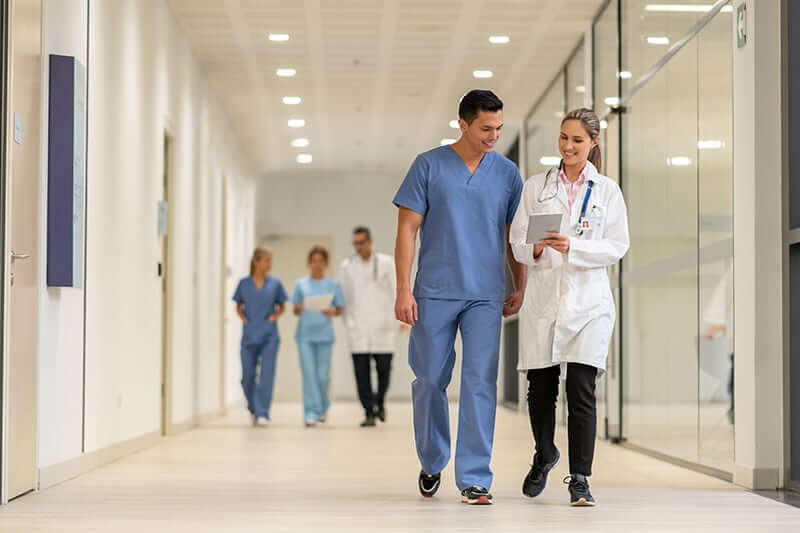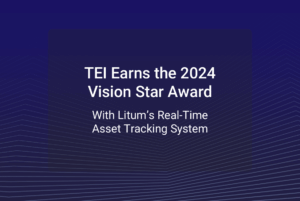Contents
As any medical professional knows, safety in the hospital environment is paramount. Now more than ever, hospitals need to ensure that staff members are safe and accounted for at all times. This is where hospital RTLS comes into play as the best way to ensure the safety of employees.
Hospital RTLS ensures staff safety, enhancing focus on patient care and perimeter safety. Let’s explore the use of RTLS systems in healthcare facilities and how they improve safety within the perimeters.
What is RTLS And How Does It Work in Hospitals?
RTLS technology tracks people, equipment, and even animals in real time for precise location monitoring. It tracks movement in an area using wireless sensors, radio frequency identification tags, and transmitters. Hospitals have used this technology for years to make patients safer and run things smoother. Now, it can also keep the staff safe.
Hospital RTLS tracks and monitors hospital staff in real time. It uses wireless technologies such as Bluetooth Low Energy (BLE), Wi-Fi, or Ultra Wideband (UWB), depending on the needs of the system user.
How Does RTLS Work in Hospitals?
Healthcare facilities use tags worn by staff to create real-time location systems, communicating with fixed receivers. This helps administrators know each staff member’s precise location.
Hospital RTLS not only shows where staff are but also includes special features like tracking medical assets. It tracks patient throughput, alerts staff about restricted areas, monitors medical equipment, and automates tasks like room cleaning schedules. This helps hospitals manage information better and improve efficiency while keeping patients safe.
How Does Hospital RTLS Protect Staff?
Working in a hospital can be extremely stressful, especially when it comes to managing staff and resources. That’s why healthcare facilities often implement a real-time location system. Here are some ways in which a hospital RTLS protects its staff from potential harm.
Accurate Visibility of Staff Members
With an RTLS system, you can easily monitor the whereabouts of staff members throughout the facility at any given time. This helps ensure that everyone is where they should be and eliminates the need for manual attendance check-ins. The accuracy of healthcare RTLS systems also makes it easier to track staff hours for payroll purposes.
Improved Communication
RTLS systems make communication between medical staff much simpler. Administrators can swiftly assign tasks or send messages to individuals or groups without needing physical location. This makes sure important tasks get done fast and efficiently, without spending time searching for specific people
Improved Security
One of the main benefits of using a healthcare RTLS system is improved security. With the ability to track and monitor individuals in real time, administrators can quickly identify potential safety risks and intervene before any harm is done. The data collected by the system can also be used to identify trends or patterns that could lead to potential security issues in the future, allowing administrators to stay one step ahead of any potential problems.
Benefits of Using Hospital RTLS
While safety and efficiency are primary, RTLS in hospitals brings numerous additional advantages worth exploring. Let’s find out more about the advantages of RTLS in the hospital setting.
Improved Patient Safety and Care Quality

Using RTLS in hospitals notably improves patient care. Real-time location data helps healthcare staff quickly locate vital equipment, identify critical areas, and avoid care delays. Furthermore, real-time locating systems track valuable hospital assets like ventilators or defibrillators, ensuring their constant availability.
Reduced Costs and Increased Efficiency
Hospitals can also benefit from using RTLS through reduced operational costs and increased efficiency. For instance, tracking medical equipment locations helps hospitals manage inventory efficiently, reducing unnecessary purchases and optimizing inventory levels.
Likewise, staff save time searching for items as they instantly view their real-time locations on computers or mobile devices. This boosts departmental efficiency and cuts waste by avoiding overstocking or purchasing duplicates due to poor inventory management.
Improved Care Quality
Healthcare providers leverage RTLS-generated data to acquire crucial insights into their facilities and identify areas for enhancement.
By monitoring activity patterns such as patient wait times and procedure completions, hospital administrators can evaluate performance and pinpoint areas for improvement. This enables facilities to optimize resource allocation while maintaining consistent standards of quality care and patient satisfaction.
Case Studies On Hospital RTLS
In the wake of rising cases of Covid-19, hospitals are undertaking stringent infection prevention and control measures. This involves using tools and processes to isolate and treat infected people or areas at risk of infection.
Using an RTLS system, the hospital improved the visibility in monitoring staff and patients. The RTLS platform also helped introduce a Contact Tracing solution to optimize the process of automating data capture, reporting, and analysis of the proximity between staff, visitors, and patients.
During emergencies, Field Hospitals mimic healthcare systems, offering treatment and triage environments with suitable technology. Ultrasound-based RTLS tracks staff and equipment movement, making it vital for contact tracing and infection control in mobile medical systems.
A pre-eminent healthcare system faced troubles with fatal workplace violence with the nurses reporting physical attacks by patients and visitors. Over time, the campus realized the need for stronger staff security, despite having active security measures and panic buttons. The healthcare security team can use an RTLS Staff Duress system for quick and effective emergency response.
The Future of RTLS in the Hospitals
RTLS has revolutionized how medical staff, patients, and equipment are tracked inside a healthcare facility. From personnel tracking to asset management, RTLS systems provide healthcare providers with enhanced safety and efficiency.
Technology is constantly changing and improving; so what does the future hold for Healthcare RTLS solutions?
Healthcare RTLS technology is already helping healthcare facilities in many ways. It provides essential data on patient movement patterns and staff locations, resulting in improved workflow efficiency. RTLS can also help reduce the risk of lost or stolen equipment by providing real-time tracking information.
In addition, it allows medical staff to quickly locate critical supplies and equipment such as defibrillators and wheelchairs. This reduces response time for emergencies and increases patient safety.
As technology advances, we can expect to see more efficient, cost-effective solutions for every healthcare organization. Cloud-based systems will become more popular due to their scalability and ability to store large amounts of data securely.
Additionally, new technologies such as artificial intelligence (AI) will be leveraged to provide more accurate insights into patient movements and staff activities within a facility. This could lead to improved patient outcomes by enabling medical professionals to anticipate needs before they arise.
The more recent utilization of Ultra Wide Band (UWB) in RTLS systems provides accurate location data at long distances with extremely low power consumption. This makes it ideal for healthcare applications where accuracy is paramount but battery life must be maximized.
Additionally, UWB’s ability to penetrate walls and other obstacles makes it an excellent choice for indoor applications where GPS signals may be blocked or unreliable. Furthermore, UWB supports much higher data rates than other wireless technologies which allows it to process large amounts of data quickly and accurately.
With a rising decline in healthcare workers and the need to scale operational efficiency but also cut down on healthcare costs, RTLS solutions that facilitate asset management in real-time are in high demand.
The future of RTLS in healthcare systems is a bright prospect and will become increasingly so if utilized in an ideal combination of innovation and technology to suit various medical tasks.
Litum – Providing Reliable Hospital RTLS Solutions
A healthcare setting is challenging to navigate, and more so, to operate. An RTLS solution intended to boost the operational efficiency of the facility also comes with its challenges.
Fortunately, Litum offers RTLS Healthcare services like real-time asset tracking and hospital staff tracking services designed specifically for clinics, hospitals, and senior living centers.
Our system allows you to secure assets including staff and hospital equipment, monitor patient flow status constantly to counter abductions, falls, and no-zone wandering, as well as follow up with inactivity alerts.
Our comprehensively connected system design includes operations like patient flow, care monitoring, workload management, logistics management, and claim mitigation suited for organizations of all capacities.
If what you seek is a customized healthcare professional safety RTLS Solution for your hospital system, reach out to Litum today and explore our numerous RTLS-based solutions at your convenience.






